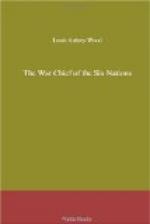But the Quaker would have none of them, and sent the searchers on their way. Then Captain McKean wrote a letter to Brant. Placing this in a stick, he cast it on an Indian path, where it was soon found by a redskin and carried to the War Chief’s wigwam. In the letter McKean arraigned Brant for the ferocious manner in which he was fighting, and dared the Mohawk chief to single combat, or to send a chosen body of men to meet him in fair field against an equal number. If he showed his face in Cherry Valley, threatened McKean, ’they would change him from a Brant into a Goose.’
Brant knew the impulsive nature of McKean and took this amusing letter for what it was worth. Yet the letter was not without its effect upon him. They had dared him; they had taunted him with threats; he would show them that Joseph Brant would have a day of reckoning and that right early. ‘Cherry Valley people,’ he wrote in the postscript of a short note sent to an ardent loyalist, ’[are] very bold, and intended to make nothing of us; they call us wild geese, but I know the contrary.’
Early in July a bloody engagement had occurred in the valley of Wyoming, an extensive region in Pennsylvania on the north branch of the Susquehanna river. For many years after the encounter it was commonly believed that Brant was the leader of the Indians who took part in it. The valley of Wyoming had once been a possession of the tribes of the Six Nations but, in 1754, they had been ousted from their inheritance by a colonizing company. When the Revolutionary War began it was already well peopled with settlers. Naturally eager for vengeance, the dispossessed Indians invited the co-operation of Colonel John Butler and his rangers in a raid. Butler accepted the invitation, and the Indians and rangers to the number of five hundred made a swift descent of the Susquehanna and invaded the valley. Their approach, however, had been discovered, and the entire militia of the district, mustering eight hundred, advanced against them. In the battle which followed, the defenders were defeated with great slaughter and many scalps were taken. Older American historians misrepresented the fight as a cruel massacre of non-combatants and asserted that Brant was present. British writers, following them, fell into the same error. Thomas Campbell’s poem, ’Gertrude of Wyoming,’ written in 1809, gives a gruesome picture of the episode, telling of the work which was done by the ‘monster Brant.’ During his visit to England in 1823, the War Chief’s youngest son, John Brant, vindicated his father in a letter to Campbell, and showed that the reference to his father in this poem was based on false information. He declared that ‘living witnesses’ had convinced him that his father was not in the neighbourhood of Wyoming at the time of the so-called massacre; testimony has been forthcoming to support the claims which John Brant then made. It has been shown that the tribesmen of the Six Nations




